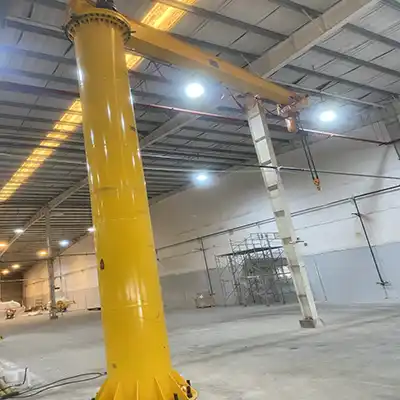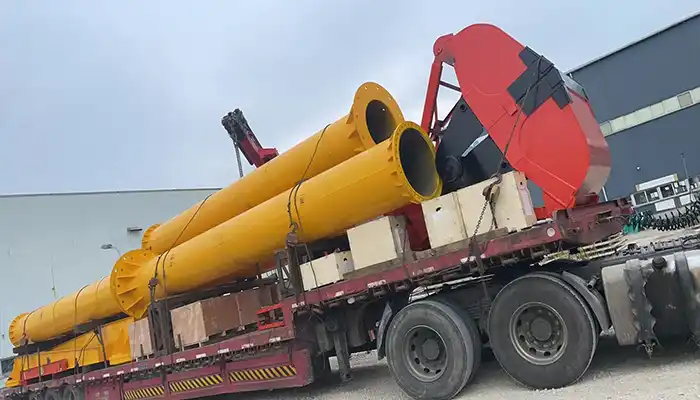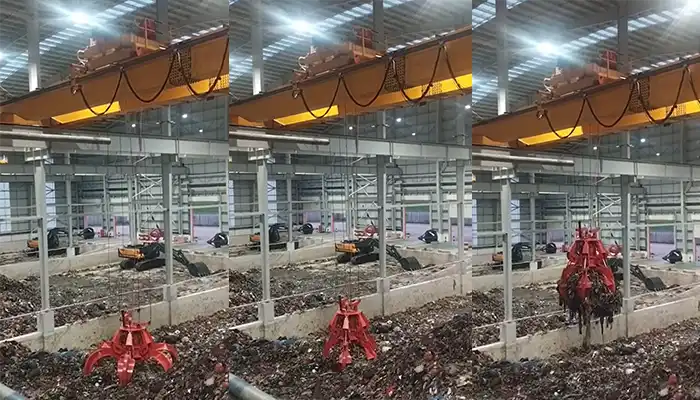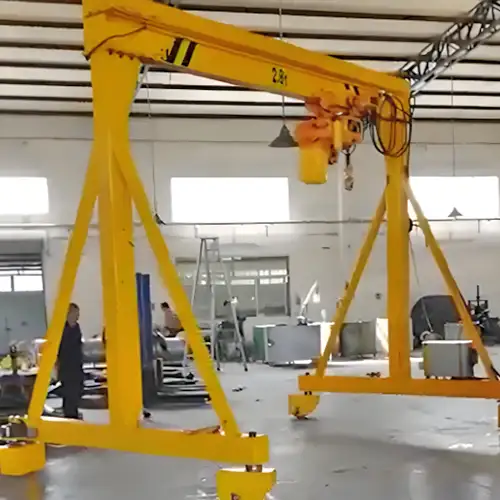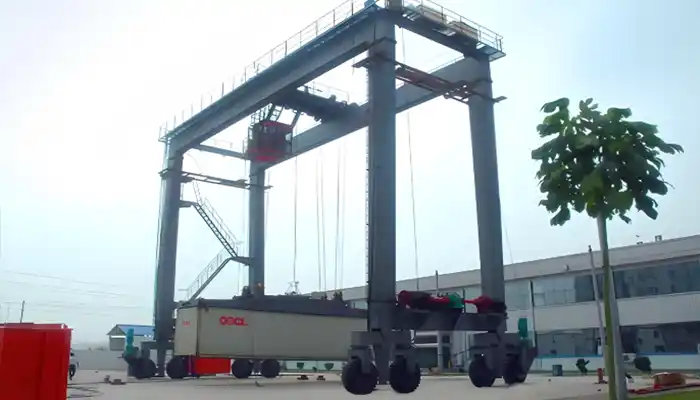
Cost & Maintenance of Railroad Rubber-Tyred Gantry Cranes
Cost and Maintenance Considerations for Rubber-Tyred Gantry Cranes in Railroad Container Operations
What Are Rubber-Tyred Gantry Cranes (RTGs)?
Key Features of RTGs:
- Mobility: Can travel across the yard, providing flexibility in container movement.
- Container Handling: Able to lift and stack containers of various sizes.
- Efficiency: Speeds up the transfer of containers between trucks and trains, reducing downtime.
Why Are RTGs Important in Railroad Container Operations?
RTGs are a key component in the efficient operation of railroad container terminals. Their primary role is to streamline the transfer of containers, reducing the time it takes to load and unload trucks and trains. This ability to move containers quickly leads to improved efficiency and reduced waiting times.
Additionally, RTGs help optimize yard space by stacking containers, which allows more containers to be stored in the same area. This maximizes the use of available space and contributes to a more organized and productive yard environment.
Benefits of RTGs in Railroad Operations:
- Time Savings: Quick loading and unloading of containers reduce operational delays.
- Space Optimization: RTGs can stack containers, improving yard organization.
- Increased Productivity: By operating efficiently, RTGs help meet tight schedules in busy rail yards.
What Will This Guide Cover?
This guide will focus on the cost-effectiveness and maintenance considerations for RTGs. We will discuss how RTGs can provide value over the long term and explore the maintenance needs required to keep them running smoothly.
Main Areas Covered:
- Cost-Effectiveness: Exploring how RTGs save money over time through increased efficiency and productivity.
- Maintenance Requirements: A detailed look at the maintenance needs of RTGs to ensure long-lasting performance and avoid costly repairs.
Initial Costs of Rubber-Tyred Gantry Cranes
Purchase Price:
Factors Influencing the Initial Cost of RTGs
The initial purchase price of a rubber-tyred gantry crane can vary widely based on several factors. The most significant of these include the crane’s load capacity, size, and specific design features. Larger cranes with higher lifting capacities typically cost more due to the additional materials and engineering required. In addition, the intended operational environment plays a role—RTGs designed for extreme weather conditions or heavy-duty operations may have higher upfront costs.
Key Factors Affecting Purchase Price:
- Load Capacity: Cranes with a higher lifting capacity (e.g., 40-ton vs. 10-ton) will be more expensive.
- Size and Design: Larger cranes with more complex designs require more materials and labor.
- Environmental Adaptations: Cranes built to withstand extreme temperatures or corrosive environments often come at a higher price.
- Technology and Features: Advanced control systems and automation features can also add to the cost.
Customizations and Features:
Cost Implications of Tailored Solutions
While standard RTGs come with basic features, many operations require specific customizations to meet their unique needs. These custom solutions can significantly impact the cost of the crane. Customizations may include changes to load capacity, operational speed, or the addition of advanced technology like automated guidance systems, remote control features, or safety enhancements.
Examples of Customization Costs:
- Load Capacity Adjustments: Modifying a crane for higher or lower load limits can increase costs.
- Operational Speed: RTGs with faster lifting and movement speeds often come at a premium.
- Control Systems: Adding advanced control systems for improved efficiency or automation can raise the price.
- Safety Features: Custom safety measures, like collision avoidance or anti-sway technology, can add to the overall cost.
Installation Costs:
Breakdown of Installation Processes and Site Preparation Needs
The installation of RTGs requires careful planning and site preparation. Unlike fixed cranes, RTGs need a clear, level area to operate, and sometimes additional infrastructure needs to be built or modified. Site preparation involves clearing the space, reinforcing the ground, and possibly adjusting the layout of the rail yard or container terminal to accommodate the crane's movement and operation.
Installation Cost Considerations:
- Site Preparation: Costs associated with preparing the ground, leveling surfaces, and ensuring safe movement paths for the crane.
- Foundation Work: Depending on the crane's weight and specifications, a reinforced foundation or specialized ground support may be required.
- Electrical and Control Systems: RTGs typically require power sources for operation, which may include laying electrical cables or installing new control systems.
- Operator Training: The cost of training crane operators is often included in the installation process to ensure they are familiar with the equipment.
In conclusion, the initial costs of rubber-tyred gantry cranes are influenced by several factors, from the basic purchase price to custom features and the complexity of the installation process. Being aware of these costs helps businesses plan their budgets and understand the financial investment required for RTG operations.
Operational Costs Over Time
Fuel and Energy Consumption: Comparative Analysis of RTGs’ Fuel Efficiency and Energy Requirements
One of the major operational costs of rubber-tyred gantry cranes (RTGs) is fuel and energy consumption. Since RTGs are typically powered by diesel engines or electric motors, fuel costs for diesel-powered models can be significant, particularly for high-usage operations. Electric RTGs, while having a higher initial investment, can be more cost-effective in the long run as they have lower energy consumption and do not require frequent refueling.
Factors Affecting Fuel and Energy Consumption:
- Fuel Type: Diesel RTGs require frequent refueling, contributing to higher ongoing fuel costs. Electric RTGs may have a higher initial cost but often provide savings through lower energy consumption.
- Operation Intensity: The more frequently the crane operates, the higher its fuel or energy usage. RTGs running at full capacity for extended periods will use more energy.
- Operational Speed and Efficiency: RTGs with more advanced control systems that optimize speed and movement can reduce energy waste, improving overall fuel efficiency.
Labor Costs:
Impact on Labor Costs, Including Operators and Maintenance Staff
Labor costs are another significant part of the operational expenses for RTGs. These costs are primarily associated with the number of operators and maintenance staff required. RTGs are operated by trained personnel, and the number of operators needed will depend on how the yard is organized and how many cranes are in operation. In addition, maintenance staff are essential to keeping the cranes running smoothly, as regular checks and repairs are necessary to prevent breakdowns and extend the crane’s lifespan.
Key Labor Cost Considerations:
- Number of Operators: Depending on the workload and operational hours, multiple operators may be required for shifts. Automated RTGs can reduce the number of operators needed, but skilled personnel are still necessary for monitoring and troubleshooting.
- Maintenance Staff: Regular maintenance is required to keep RTGs in good working condition, including routine checks, oil changes, and part replacements. Depending on the complexity of the equipment, additional maintenance staff may be needed.
- Operator Salaries: Skilled crane operators, especially those who work with more advanced or automated systems, typically require higher wages due to their specialized training.
Training Costs:
Investment in Operator Training for Optimal Safety and Efficiency
Proper training is essential to ensure that RTGs are operated safely and efficiently. Operators must be familiar with the crane’s control systems, safety features, and best practices to maximize productivity and minimize the risk of accidents. Training programs often involve both classroom instruction and hands-on experience, and the cost of training can vary depending on the complexity of the equipment and the experience of the operators.
Key Training Cost Factors:
- Initial Training Investment: The cost of training new operators, including the time required for training and the resources (e.g., instructors, facilities) involved.
- Ongoing Training: As technology advances, operators may require ongoing training to keep up with new systems or procedures.
- Safety and Compliance: Investment in training to ensure compliance with industry regulations and safety standards. Proper training helps reduce the likelihood of accidents, which can be costly in terms of both human resources and insurance premiums.
In conclusion, while RTGs offer significant benefits in terms of operational efficiency, their ongoing costs—such as fuel, labor, and training—should not be overlooked. Understanding these costs and planning for them can help businesses optimize their operations and make informed decisions about their equipment investments.
Long-Term Cost Effectiveness
Durability and Longevity:
Assessing the Lifespan of RTGs
One of the key factors that contribute to the long-term cost-effectiveness of rubber-tyred gantry cranes (RTGs) is their durability and longevity. On average, an RTG can last anywhere from 20 to 30 years, depending on how well it is maintained and the level of usage. RTGs that are well-maintained and operated in optimal conditions can reach the higher end of this lifespan, providing many years of reliable service.
Factors Affecting Durability and Longevity:
- Maintenance Practices: Regular inspections, routine maintenance, and timely repairs can significantly extend the life of an RTG.
- Environmental Conditions: RTGs operating in harsh conditions (e.g., extreme temperatures, corrosive environments) may experience wear and tear more quickly, reducing their lifespan.
- Usage Intensity: High usage in busy terminals can cause more frequent breakdowns, leading to higher maintenance costs and a potentially shorter lifespan if not properly managed.
Productivity Gains:
Enhancing Operational Efficiency and Throughput
Another significant factor contributing to the long-term cost-effectiveness of RTGs is their impact on productivity. By allowing for faster loading and unloading, better space utilization, and quicker turnaround times, RTGs directly contribute to higher operational efficiency. The ability to move containers quickly between trucks and trains reduces delays, minimizes idle time, and maximizes throughput.
How RTGs Improve Productivity:
- Faster Container Handling: RTGs can quickly lift, transport, and stack containers, reducing wait times and speeding up the entire process.
- Space Optimization: By efficiently stacking containers, RTGs make better use of yard space, allowing more containers to be handled in a given area.
- Reduced Delays: With less downtime and faster turnaround times, RTGs ensure that rail operations stay on schedule, increasing overall throughput.
These productivity gains directly translate into cost savings, as more containers can be moved with fewer delays, reducing operational costs and increasing overall efficiency.
Return on Investment (ROI):
Factors Contributing to ROI from Reduced Downtime and Increased Productivity
The return on investment (ROI) for RTGs is largely driven by their ability to reduce downtime and boost productivity. The more efficient and reliable an RTG is, the fewer disruptions there will be in the operation, leading to lower costs and higher revenues over time. RTGs that experience minimal breakdowns and require less maintenance have a better ROI, as they stay operational for longer periods and keep operations running smoothly.
Key ROI Drivers:
- Reduced Downtime: RTGs with minimal breakdowns and faster repair times contribute to less lost production and fewer delays.
- Increased Throughput: Higher container handling rates mean more containers are processed, leading to greater revenue generation for the terminal or rail yard.
- Lower Maintenance Costs: RTGs that are built to last and require less frequent repairs save on long-term maintenance expenses, improving profitability.
By reducing downtime, increasing throughput, and minimizing maintenance costs, RTGs deliver strong returns on investment over their lifespan. The combination of durability, productivity, and low maintenance costs makes them a highly cost-effective solution for container handling operations in the long run.
Maintenance Requirements
Routine Maintenance Tasks: Overview of Common Maintenance Tasks
To ensure that rubber-tyred gantry cranes (RTGs) operate efficiently and last as long as possible, regular maintenance is essential. Routine tasks focus on keeping the crane in good working condition and preventing issues before they lead to more costly repairs. Common maintenance tasks include:
- Inspection: Regular inspections are crucial to identify any wear and tear, damage, or misalignment. This includes checking structural components like the crane's frame, hoisting systems, and cables.
- Lubrication: Many moving parts in the crane, such as the wheels, joints, and hoisting mechanisms, need to be regularly lubricated to reduce friction and prevent premature wear.
- Tire Checks: Since RTGs rely on rubber tires for mobility, ensuring the tires are in good condition is essential. Regular checks help detect issues like tire wear, leaks, or misalignment, which could affect performance or safety.
By performing these tasks routinely, operators can keep their cranes running smoothly and prevent more severe mechanical failures down the road.
Preventive Maintenance: The Importance of Scheduled Maintenance
Preventive maintenance is all about proactively maintaining the crane to avoid unexpected breakdowns. Scheduling regular maintenance intervals helps identify potential issues before they become serious, reducing unplanned downtime and minimizing costly emergency repairs. Preventive maintenance typically includes more comprehensive checks of the crane’s systems and components, as well as any necessary adjustments.
Why Preventive Maintenance is Essential:
- Extends Equipment Life: Regular care helps prevent excessive wear and tear, significantly extending the crane's operational lifespan.
- Minimizes Downtime: Scheduled maintenance ensures that small issues are addressed before they cause major disruptions, keeping the crane available for use.
- Reduces Repair Costs: By catching problems early, preventive maintenance prevents costly repairs and parts replacements that may arise from neglect.
Routine checks, when done regularly, help in identifying issues that may not be visible during day-to-day operations, saving time and money in the long term.
Parts Replacement and Upgrades: Common Components That Require Replacement
Despite careful maintenance, certain parts of RTGs will need to be replaced over time. Understanding which components typically wear out and planning for their replacement helps manage long-term costs effectively. Common parts that often require replacement include:
- Tires: The rubber tires wear down over time due to constant movement and heavy loads. Replacing tires regularly helps maintain performance and safety.
- Brake Pads and Systems: Brake components are subject to frequent use and wear. These need to be checked and replaced to ensure safe operation.
- Batteries (for Electric RTGs): Over time, the battery systems that power electric RTGs may lose their efficiency and need to be replaced.
- Electrical Systems: Wiring and control systems may degrade or suffer damage due to wear and environmental exposure, requiring periodic replacement or upgrades.
Although parts replacement adds to maintenance costs, planning for these changes can minimize downtime and maintain the crane’s efficiency. Some components, such as tires or brakes, might need to be replaced more frequently, while others like structural parts may last the entire lifespan of the crane.
Technological Advances in Maintenance:
How Modern Diagnostic Tools and Automated Systems Are Changing Crane Upkeep
Advancements in technology have transformed crane maintenance practices, making it easier and more efficient to keep rubber-tyred gantry cranes in top condition. Modern diagnostic tools, such as predictive maintenance software, sensors, and automated monitoring systems, can provide real-time data about the crane’s performance, helping operators spot issues early.
How Technology is Changing Maintenance:
- Predictive Maintenance: By using sensors and monitoring tools, predictive maintenance software can analyze data to forecast when a part might fail or when maintenance is required. This reduces unnecessary maintenance and prevents unplanned downtime.
- Remote Monitoring: Many RTGs are now equipped with remote monitoring systems that allow maintenance teams to check crane performance and diagnose issues from a distance, improving efficiency.
- Automated Diagnostics: Automated systems within the crane can detect faults or deviations in performance and alert operators immediately, reducing the risk of accidents or severe damage.
These advancements improve the accuracy and timing of maintenance interventions, ultimately extending the crane's life and reducing long-term costs. Additionally, technology allows for more streamlined and effective use of resources, which can reduce the need for constant physical inspections and lower labor costs.
By investing in advanced diagnostic tools and leveraging automation, crane operations can achieve better upkeep and maximize the return on investment for their RTGs.
Downtime and Repairs
Frequency and Duration of Downtime: Analysis of How Often RTGs Require Downtime for Repairs
While rubber-tyred gantry cranes (RTGs) are designed for continuous use in container handling operations, they will inevitably experience downtime for repairs and maintenance. The frequency and duration of these downtimes depend on several factors, including the crane’s age, usage intensity, and how well it’s maintained. On average, an RTG may experience downtime anywhere from a few hours to several days per year, depending on the severity of the issue.
Factors That Affect Downtime:
- Age of the Crane: Older RTGs, especially those beyond their prime years, may experience more frequent breakdowns, leading to increased downtime.
- Operational Conditions: Harsh environmental conditions, such as extreme weather or corrosive environments, can lead to more wear and tear, increasing downtime for repairs.
- Maintenance Practices: RTGs that receive consistent, high-quality preventive maintenance are less likely to experience long or frequent downtime compared to those that are neglected.
While downtime is inevitable, minimizing its duration and frequency is crucial for maintaining operational efficiency. Long periods of downtime can lead to delayed shipments, reduced throughput, and financial losses.
Cost of Unplanned Repairs:
Exploring the Financial Impact of Emergency Repairs and Unexpected Breakdowns
Unplanned repairs, especially those arising from unexpected breakdowns, can have a significant financial impact on the overall cost of operating RTGs. When a crane breaks down unexpectedly, it often leads to emergency repairs, which are generally more expensive than routine maintenance. This cost can also include lost productivity during the downtime, labor expenses for unplanned repairs, and even the costs of hiring specialized technicians.
Financial Impacts of Emergency Repairs:
- Higher Labor Costs: Emergency repairs usually require technicians to work outside of regular hours, which often results in overtime charges.
- Parts and Components: Replacing damaged or worn-out parts quickly can be costly, especially if these parts are not readily available or need to be custom-ordered.
- Lost Productivity: When RTGs are down, it impacts the entire terminal's efficiency, leading to delays in container handling and potential financial losses from missed schedules.
These unexpected costs emphasize the importance of having a well-planned maintenance strategy to avoid the need for emergency repairs as much as possible.
Minimizing Downtime: Strategies to Reduce Downtime
Reducing downtime is critical to ensuring that RTGs operate efficiently and avoid the high costs associated with emergency repairs. Implementing a few key strategies can help minimize downtime and keep RTGs running smoothly.
Effective Strategies to Minimize Downtime:
- Predictive Maintenance: Predictive maintenance tools use data from sensors to detect potential issues before they lead to breakdowns. By anticipating problems, maintenance can be performed during scheduled downtime, preventing unexpected repairs.
- Regular Inspections: Performing frequent, detailed inspections can catch small issues early, before they escalate into costly repairs. Regular inspections help identify components that need attention or replacement.
- Spare Parts Availability: Maintaining an inventory of critical spare parts ensures that necessary components can be replaced quickly, reducing downtime. This strategy is especially effective for high-use parts like tires, brake pads, and batteries.
- Training Operators: Properly trained operators are more likely to identify minor issues before they develop into serious problems, preventing unnecessary downtime and ensuring smooth operations.
By utilizing these strategies, terminal operators can significantly reduce downtime and keep their RTGs performing at peak efficiency, leading to higher productivity and lower operational costs. Investing in preventive measures not only minimizes the risk of unplanned breakdowns but also improves the overall cost-effectiveness of RTGs in the long term.
Safety and Regulatory Compliance Costs
Safety Standards and Certifications: Costs Associated with Ensuring Compliance
In the realm of container handling, safety is paramount. Rubber-tyred gantry cranes (RTGs) must meet various safety standards to ensure safe operations and protect both workers and equipment. Complying with industry regulations such as OSHA (Occupational Safety and Health Administration) and ISO (International Organization for Standardization) often involves significant upfront costs. These expenses are necessary to ensure that cranes meet the required safety benchmarks and certifications, which can include:
- Regular Safety Inspections: RTGs must undergo regular safety inspections to ensure they meet industry standards. These inspections may require third-party certification, adding to operational costs.
- Safety Upgrades: Upgrading older RTGs to meet newer safety standards can be costly. This may involve adding safety features like improved warning systems, safety barriers, and enhanced lifting mechanisms.
- Training and Documentation: Investing in employee training for safety protocols, and maintaining the necessary documentation for compliance, contributes to additional expenses. This includes educating operators about safety measures, proper handling of equipment, and emergency response procedures.
While these costs may seem significant, they are essential for maintaining a safe working environment, minimizing the risk of accidents, and avoiding potential fines for non-compliance.
Impact on Operational Efficiency:
How Safety Improvements Might Add Costs but Enhance Long-Term Performance and Reduce Liability
While meeting safety regulations adds costs, the long-term benefits often outweigh these expenses. Safety improvements can lead to higher operational efficiency, fewer accidents, and reduced liability risks. Some of the ways in which safety measures impact operational performance include:
- Reduced Accidents and Injuries: Investing in safety features, such as advanced control systems and collision detection, can significantly reduce the risk of accidents. Fewer accidents lead to less downtime and avoid the costs of medical bills, insurance claims, and legal fees.
- Higher Worker Productivity: When employees feel safe, they are more likely to work efficiently and with confidence. Safe work environments foster higher morale and productivity, which ultimately contributes to better throughput and operational efficiency.
- Long-Term Cost Savings: While safety measures may involve initial expenses, they can result in significant savings over time by reducing the likelihood of costly accidents, downtime, and potential legal fees.
By viewing safety as an investment rather than just a cost, terminal operators can enhance both short-term productivity and long-term profitability, all while maintaining a safe environment for workers.
Risk Mitigation:
Investment in Safety Systems and Risk Management
Investing in safety systems and effective risk management strategies helps minimize the likelihood of accidents that could disrupt operations. By proactively addressing potential hazards and implementing appropriate safeguards, RTG operations can avoid costly damages and protect both human and material assets. Key risk mitigation strategies include:
- Automated Safety Features: Modern RTGs are often equipped with automated safety systems, such as load sensors, collision avoidance technology, and emergency stop functions. These systems help detect and prevent dangerous situations before they occur, reducing human error and potential harm.
- Comprehensive Risk Assessment: Conducting regular risk assessments allows operators to identify and address hazards before they lead to accidents. This includes assessing the crane’s operating environment, load handling capabilities, and potential impact on surrounding infrastructure.
- Emergency Preparedness and Response: Implementing effective emergency response protocols, such as evacuation plans and first aid training, helps ensure that the workforce is prepared for unexpected incidents. Additionally, proper insurance coverage for both property and liability protects the business from the financial consequences of accidents.
By investing in these safety measures, crane operators can significantly reduce the likelihood of accidents, saving money on insurance premiums, legal fees, and equipment repair costs while protecting workers and maintaining operational continuity. This proactive approach to risk management is a key part of ensuring the long-term success and profitability of RTG operations.
Environmental Impact and Sustainability Costs
Emission Reduction and Eco-Friendly Features
The Role of RTGs in Reducing Carbon Emissions and Environmental Footprint
In today’s world, environmental sustainability is becoming increasingly important for businesses, including those involved in railroad container operations. Rubber-tyred gantry cranes (RTGs) are playing an essential role in reducing carbon emissions and minimizing their environmental footprint. As the push for greener operations intensifies, RTGs are being designed and modified to meet eco-friendly standards. Key features that contribute to emission reduction and sustainability include:
- Electric-Powered RTGs: Many modern RTGs are being equipped with electric or hybrid engines, reducing the reliance on diesel fuel and significantly lowering emissions. Electric RTGs help minimize the environmental impact by reducing air pollution and noise, making them ideal for operations in urban and port areas with strict environmental regulations.
- Energy Regeneration: Some RTGs are designed to regenerate energy during braking, converting kinetic energy back into electricity and feeding it back into the grid. This feature helps reduce energy consumption and improves overall efficiency, reducing operational costs in the long run.
- Lower Fuel Consumption: RTGs equipped with fuel-efficient engines help reduce both fuel costs and the carbon emissions associated with diesel-powered machinery. This is particularly important as industries face pressure to reduce their greenhouse gas emissions.
By investing in RTGs with eco-friendly features, terminal operators not only comply with environmental regulations but also enhance their sustainability efforts and corporate social responsibility profiles.
Sustainability in Maintenance
Considerations for Sustainable Maintenance Practices
Sustainability doesn't just apply to the operations of RTGs; it also extends to their maintenance and the management of resources throughout their lifespan. Incorporating sustainable maintenance practices helps reduce waste, conserves resources, and lowers the environmental impact of crane upkeep. Key considerations for sustainable maintenance practices include:
- Recycling and Disposal of Parts: Using recycled materials when replacing parts and ensuring proper disposal of old components reduces the environmental impact of RTG maintenance. Many parts, such as tires and hydraulic fluids, need to be carefully managed to prevent contamination and to reduce landfill waste.
- Eco-Friendly Lubricants and Fluids: Using biodegradable and non-toxic lubricants and fluids in maintenance routines ensures that harmful chemicals do not pollute the environment. Sustainable lubricants reduce the risk of soil and water contamination, while also providing effective performance for RTGs.
- Proper Waste Management: Implementing a comprehensive waste management program in maintenance facilities helps keep hazardous materials like oils, solvents, and batteries under control. Recycling metal parts, cleaning solvents, and other materials are an essential part of reducing waste in crane operations.
Sustainable maintenance practices not only help reduce environmental impact but also contribute to the longevity of the RTGs and can even lower operating costs over time by reducing the need for frequent repairs and replacements.
Cost Implications of Green Technologies:
Cost Considerations of Adopting Energy-Efficient and Eco-Friendly Technologies
Adopting energy-efficient and eco-friendly technologies in RTG operations often comes with upfront costs. While these green technologies may require higher initial investments, the long-term benefits typically offset these costs through energy savings, reduced emissions, and lower environmental fines. Key cost considerations include:
- Initial Investment in Eco-Friendly Features: Upgrading to electric or hybrid RTGs, implementing energy regeneration systems, or adopting advanced emissions-control technologies may increase the initial purchase price of the crane. However, these features typically offer savings in fuel consumption and operating costs over time.
- Government Incentives and Subsidies: Many governments offer incentives, subsidies, or tax breaks for businesses investing in green technologies. These incentives can help offset the initial costs of adopting energy-efficient or eco-friendly RTGs, making the transition more affordable.
- Lower Operating Costs: Once green technologies are in place, businesses can enjoy reduced fuel and energy costs, contributing to long-term savings. Additionally, fewer emissions can result in lower environmental compliance costs and avoid penalties for exceeding pollution limits.
While the transition to greener RTGs requires investment, the long-term financial, operational, and environmental benefits make it a worthwhile commitment for operators who are committed to sustainability.
Conclusion
Summary of Key Cost Considerations
Rubber-tyred gantry cranes (RTGs) are essential for efficient container handling in railroad operations, but they come with various cost factors to consider. From the initial purchase price, which can be influenced by crane capacity, custom features, and installation needs, to ongoing operational expenses such as fuel, labor, and training costs, managing RTG costs requires careful planning. Maintenance requirements, both routine and preventive, play a critical role in keeping RTGs running smoothly, and adopting the latest safety and green technologies can further add to upfront costs but reduce long-term operational costs. Additionally, minimizing downtime and addressing unplanned repairs through predictive maintenance strategies can significantly improve overall cost-effectiveness.
Strategies for Maximizing Cost Efficiency
To maximize the cost-efficiency of RTGs, operators should focus on several strategies:
- Invest in Predictive Maintenance: By using data analytics and monitoring tools, operators can identify potential issues before they cause costly breakdowns, ensuring RTGs operate at peak efficiency.
- Opt for Energy-Efficient Models: Investing in electric or hybrid RTGs can reduce fuel and energy costs, particularly in operations with high usage.
- Train Employees Regularly: Continuous training of operators and maintenance staff helps reduce errors, improves efficiency, and ensures compliance with safety standards, ultimately lowering operational costs.
- Adopt Preventive Maintenance Programs: Scheduled checks and servicing prevent major repairs, extend the lifespan of RTGs, and help avoid expensive emergency downtime.
- Consider Long-Term Investment in Green Technologies: While green technologies come with initial costs, they pay off in reduced energy consumption, fewer emissions, and long-term savings on operating expenses.
As RTG technology advances, the focus on efficiency, sustainability, and reduced operational costs will play a key role in shaping the future of railroad container handling operations. By staying ahead of these trends, operators can enhance the cost-effectiveness and sustainability of their RTG fleets.
